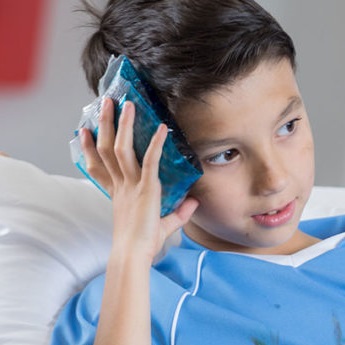What Happens if You Play Through a Concussion?

September 15, 2023
Not long ago, a student athlete who took a hit to the head was told to “shake it off” and get back in the game. Today, coaches and athletic trainers recognize the inherent danger of that philosophy.
Kevin Crutchfield, M.D., neurologist at Hackensack University Medical Center’s Concussion Center, says he sees patients who have concussions from everyday activities like falling off a bike without wearing a helmet, skateboarding or any activity that can result in a fall where the head and neck take a hit, causing brain injury.
What Happens During a Concussion?
Christine Greiss, D.O., director of the Concussion Program at JFK Johnson Rehabilitation Institute, describes a concussion as similar to having your brain shake inside your skull like a baby rattle.
“That abrasive movement can cause a disruption in brain activity, as well as blood flow. While the brain is in recovery, it can cause overall brain activity to be very slow,” she says.
This slow down in brain activity can include:
- Sensitivity to noise
- Fatigue
- Difficulty thinking clearly and learning new material, such as participating in school classes
Why Returning to Play Can Be Fatal
If an athlete gets back into the game after even a very mild concussion and sustains a
second hit, they can experience second impact syndrome, which exponentially increases the likelihood of serious brain injury.
Second impact syndrome occurs when a second injury occurs, before the brain has had time to recover and heal from the first injury. This second injury can cause symptoms ranging from disorientation and fatigue, to sudden death from the immediate brain swelling caused by the re-injury.
- According to the Sports Medicine Resource Manual, this syndrome carries a mortality rate of approximately 50 percent.
- In the United States, most reports of second impact syndrome have been in football players, but it has also been noted in hockey players and boxers.
- It is most commonly described as occurring among adolescent males 14–16 years old.
In addition, Dr. Crutchfield notes that younger brains are more susceptible to malignant cerebral edema. In this condition, the brain swells so quickly immediately after the blow, that the flow of blood and electrical impulses in the brain is disrupted. This results in symptoms that can range from headaches and dizziness to blurred vision, nausea/vomiting, confusion, lack of awareness, unconsciousness and even death.
What to Do for a Concussion
Dr. Greiss says the treatment for a mild concussion involves rest and slow return to normal physical and academic activities as symptoms recede – patience is key as this can take time, up to a few weeks.
Don’t hesitate to consult with a medical professional, experienced in treating head injury, to assess the injury and develop an appropriate recovery plan.
Next Steps & Resources:
To make an appointment with a doctor near you, call 800-822-8905 or visit our website.
Meet our sources:
- Kevin Crutchfield, M.D., Neurologist, Hackensack University Medical Center and Assistant Professor of Neurology, Hackensack Meridian School of Medicine
- Christine Greiss, D.O., Director of the Concussion Program at JFK Johnson Rehabilitation Institute and Assistant Professor of Physical Medicine and Rehabilitation, Hackensack Meridian School of Medicine






